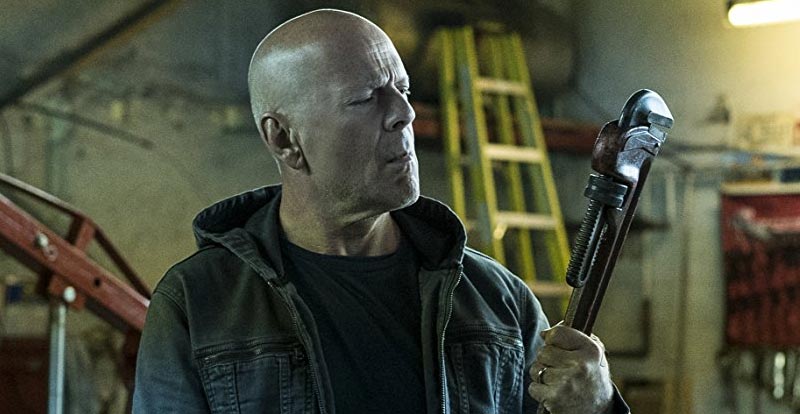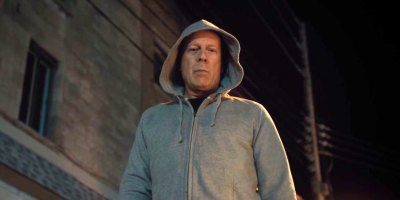
Warner Bros
‘Death Wish’ Might Just Be a Movie, But There Are Actual Vigilantes Among Us
Back in 1974, a lot of New York City was deemed nothing short of a cesspool; a breeding ground for criminals striking out against innocent people who, in turn, felt helpless to do anything about it. It was into that environment that the movie Death Wish was released — though unleashed would probably be a better word. The concept was that a man’s family was attacked, his wife killed and daughter plunged into a coma as a result. Devastated and lost, he gradually makes his way into the streets, armed, and begins taking down the muggers who attempt to do him harm. Today, things may not seem so bad on the surface, but just beneath it, there’s a renewed sense of fear. A fear of random violence, targeted violence, school shootings, vehicles running down innocent victims. The list seems to grow on a daily basis.
So for purely cathartic reasons, maybe the time is right for the character of Paul Kersey (originally played by Charles Bronson, and now played by Bruce Willis) to return in a remake of Death Wish, which hits theaters March 2. For two hours sitting back watching the movie, maybe we can get some wish-fulfillment from this film, which in some ways represents a part of society that’s always been there. The fantasy (emphasis on that word) that if our demands for justice can’t be met, we may have to pursue it ourselves. It’s certainly not a new idea — there have been and are vigilantes in the real world too, not just in movies.

(Photo Credit: Warner Bros)
“People have fantasies about cleaning up the streets, taking care of crime, and being a crime fighter. That’s one of the reasons superhero movies are so popular. It’s that idea that ordinary people have the power to stop crime and fight evil,” said Death Wish director Eli Roth in comments provided by the studio.
In the movie, Paul Kersey is a surgeon by day who then becomes known as the Grim Reaper at night, where he takes justice into his own hands having grown frustrated with the current state of the police department. Basically, Paul wants to find out who is responsible for hurting his family and he’s going about his own way. As Eli described the character, Paul is “a normal guy who’s ethical and moral, and he keeps pushing the line further in order to justify his own actions.”

(Photo Credit: Warner Bros)
Bruce Willis, though, sees his character’s actions a little differently, feeling that this was the path Paul was put on in a divine sense. “I truly believe, on a deep level, that everything happens exactly the way it’s supposed to in life,” Bruce said in the studio statement. “Approaching this film, I thought it’s clear that this character was on the path he was supposed to be on. To be a doctor, as Paul Kersey is, you have to want to help people. And then, though it came from a tragedy, after his family is attacked, Kersey gets to where he is because he’s supposed to be there — one way or the other. And all of that was in the script.”

(Photo Credit: Warner Bros)
He views Paul Kersey’s transformation through the view of parenthood, something the father of five understands well. “Before I had kids, [being a father] wasn’t a part of these action films I do. Now, it’s a major component. This film really makes you think about how far you will go to protect your family. After his own family is brutalized, Paul Kersey has zero tolerance for any bad guy to harm another innocent person. And we show the audience the underlying reasons why he does what he does.”
In reality, there is usually an underlying reason for any sort of vigilante action, whether society deems it acceptable or not, and it’s not limited to movies. There have been plenty of actual people who took it upon themselves to seek justice, in the United States and all around the world. Below, a breakdown of real-life vigilante cases, present and past.
PAT JA SAN

(Photo Credit: Getty Images)
In the Kachin State of Myanmar, where opium production is pretty much everywhere, the people there have had to deal with widespread heroin addiction. With the government failing to help, the Pat Ja San — a Christian anti-drug vigilante group — has risen to take on the problem. But as these things usually do, the situation has gotten out of control and the group has fallen under criticism for their actions, which have included setting up detox centers to forcefully detain drug users while they receive rehabilitation, to conducting raids on poppy plantations. This has led them into confrontation with armed groups, including the Myanmar military.
CJTF

(Photo Credit: Getty Images)
Boko Haram is the Islamic State in West Africa, and in their holy war against non-believers they’ve killed tens of thousands of people and turning more than two million into refugees. In response, the 30,000 member Civilian Joint Task Force (CJTF) has arisen to fight back. And while they’ve achieved some victories, they’ve also had the opposite effect of increasing violence and harm being done to more innocents. Additionally, as the numbers have swelled, members (many of whom are unemployed and now seeking payment for their actions) have been accused of atrocities of their own — the dark side of vigilantism.
Rain City Superheroes

(Photo Credit: YouTube)
These days in America, you’ll find vigilantes patrolling the streets of different U.S. cities. They might be found dressed in their own versions of superhero costumes, and in some cases, despite suffering injuries and perhaps taking away the seriousness of this kind of justice by adding a comic book element, are actually doing some good. A perfect example is in Seattle, Washington, where Mixed Martial Artist Phoenix Jones leads a group of 10 members collectively known as the Rain City Superheroes. His message basically is that criminals need to be held accountable. As he explained to ABC News, he began taking action (mostly putting a stop to street fights) as himself, but quickly realized that wasn’t a good idea.
“When I started breaking apart fights, I had no outfit or moniker or symbol, and people started recognizing me in my everyday life. It got kind of dangerous and very uncomfortable,” he told ABC. “This suit is what people recognize, and when I take the suit off, I’m able to live as close to a normal life as possible until I put it back on and am ready to defend the people of Seattle.” The ‘Real-Life Superhero Movement’ is much larger than you would imagine.
The Guardian Angels

(Photo Credit: Getty Images)
More seriously, back in 1979, Curtis Sliwa (known in recent years largely as a conservative radio talk show host) had grown tired of people being attacked in the New York City Subway and started the organization known as The Guardian Angels. They didn’t carry guns and called themselves a “safety patrol,” but their presence was prominent, with people feeling just a little safer when they saw the group’s traditional red berets and shirts emblazoned with their logo. New York mayor Ed Koch opposed them initially, though he and future administrations changed that position.
Unfortunately, in 1992 Sliwa revealed (somewhat tarnishing the group’s name and actions in the process) that several high-profile subway rescues in the 1980s were staged to maximize publicity for them, and that in New York, they largely patrolled the Restaurant Row area of midtown Manhattan rather than more dangerous locations. And yet despite this, the concept of the Guardian Angels has remained a steady one, with chapters throughout the United States and around the world in countries like Japan, Israel, South Africa, Canada, and the UK.
Bernie Goetz

(Photo Credit: Getty Images)
Considerably darker is Bernie Goetz. If you’re looking for a real-life variation of Death Wish, this is it. The crime rate of New York in the ‘70s was bad, but by the 1980s (and, really, until 1990) it was getting far worse. In 1981, Bernie, who was born in 1947 in Kew Gardens, New York, claimed that he was delivering electronic equipment when he was attacked by a trio of youths trying to rob him, smashing him into a plate-glass door and throwing him to the ground, and injuring his chest permanently. The belief is that he emotionally never recovered from that attack.
Flash forward to Dec. 22, 1984. He was riding a Manhattan subway and claims he was threatened by four muggers armed with sharpened screwdrivers. In response, he opened fire with a handgun, letting out a total of five shots and causing serious harm to all of them (one with brain damage and made a paraplegic). Nine days later, he surrendered to police, and headlines exploded everywhere, many people praising his actions and just as many condemning them. In the end, he was cleared of all charges with the exception of carrying an unlicensed firearm, for which he served eight months of a one-year sentence.

(Photo Credit: Getty Images)
When Death Wish III was released in 1985, screenwriter Don Jakoby, in an exclusive interview with us, commented, “New Yorkers pretty much have their eyes on the ball, and everyone knows the scene. There are just too many people who get hassled too often by creeps for money, and just get generally roughed up. Goetz may have been a little excessive in his zeal to shoot the four of them, but the moral of that is not to walk up to guys in a subway with sharpened screwdrivers and ask them for money. Everybody kind of figures that they asked for it. There is no bill of rights for criminals.”
So, is vigilantism the answer?

(Photo Credit: Getty Images)
Turning things back to Death Wish, author Brian Garfield, who wrote the novel the films are based on, has definitely given a lot of thought to the ramifications of any kind of vigilante justice. As for his own inspiration for writing the novel, he said in our exclusive interview, “I used to have an old convertible and had gone to a party at my publisher’s on the West End. I had parked the car down the street, and it was about 2 a.m. on a very cold winter night when I arrived at my car for the two-hour ride back to New Jersey, only to find that some vandal had slashed the convertible top to ribbons. It was a long, cold drive home.
“Then,” he continued, “the cooler thought was, ‘Wait a second. If he slashed the roof, he must have a knife, and in that case I don’t know if I want to tangle with him’ By the time I got home, I was obsessed with the idea of revenge, and it began to occur to me that we all have the right to get mad. It’s a natural reaction to this sort of thing, but there’s something dramatically interesting about someone who gets mad and stays mad.”
That’s the starting point for the novel and both films, though in the book, Paul Kersey goes into the street to make a target of himself, his intent more personal than sociological. Explains Brian, “It’s sort of the same kind of rationalization that Bernhard Goetz is alleged to have used. He’s trying to get rid of his own demons. The point I tried to make is that anybody in that position is going to end up meeting out Star Chamber justice. You put a gun in your best friend’s hand, are you going to trust him? Vigilantism is a wonderful fantasy, but when you put it into practice, it’s not a solution. It’s another problem.”

(Photo Credit: Paramount Pictures)
Wanting to put that message out there, in 1975 he wrote Death Sentence, which he refers to as a “kind of penance” for the first film. “I was somewhat nonplussed by the way that they had taken the plot of the novel,” he says, “and, without significantly altering it, had turned it into a story that had delivered exactly the opposite message to the one I was trying to deliver in the novel — that this is not a bright thing to do.
“If the streets were absolutely crowded with armed people,” Brain said, “it wouldn’t just be Dodge City, because Dodge City had a couple of hundred people. We’re talking about millions of people. I don’t think you can equate an armed citizenry with the mythologies of Wyatt Earp or Wild Bill Hickok. It just isn’t the same world.”
Have a tip? Send it to us! Email In Touch at contact@intouchweekly.com.








































